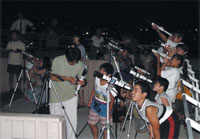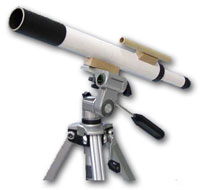Topics
Children Can See the Skies as Galileo Did
May 12, 2009
“Wow!” is what children often say when they first look through the Galileoscope that they have just made. Viewing the skies through this high-quality, inexpensive telescope opens up a new world of observation to a wide range of people—young and old; professional and amateur astronomers; those in countries around the world. Hawaii’s children will soon have a chance to share in this worldwide experience of viewing the skies through their own portable telescope.
The first of many local Galileoscope workshops will be offered at 11 a.m. on Saturday, May 30th at ‘Imiloa Astronomy Center in Hilo. It is designed for students in grades 6-8 and is limited to 20 participants. Workshop participants will receive their own telescope kit, assemble it themselves, learn about optics, and develop skills in focusing and pointing their personal telescope to view objects (except the Sun!) in the sky. They might see what Galileo saw through his telescope 400 years ago—craters on the Moon, rings around Saturn, a variety of star clusters, or moons circling Jupiter. Some say that seeing “first light” through their first telescope is a memorable and life-changing experience; they feel the joy and fun that astronomy offers.
The fee for the workshop is $20 and includes the telescope and a portable tripod that each participant can take home. Only one telescope and tripod per family will be provided. To register in advance, participants may sign up and prepay (by check or cash only) at ‘Imiloa. No credit card or online registration is available.
Subaru Telescope and ‘Imiloa have collaborated to make this event possible. Dr. Saeko Hayashi, Associate Professor at Subaru Telescope and one of the facilitators of this event, commented, “These telescopes are simple, sturdy, well-designed, and easy for families to use to observe the night sky. We want our keiki to learn to look at the wonders of the night sky and to understand what they are seeing.”
To add to the day’s education about Galileo’s telescope, a free public presentation about telescopes will take place at ‘Imiloa at 1 p.m. in Moanahōkū Hall. Subaru Telescope will provide a replica of a Galileo-vintage telescope for keiki to experience; they can learn about how the two lenses work and also the ways that telescopes help people to observe the cosmos. The public is welcome and seating will be on a first-come, first-served basis.
These activities are a local part of worldwide events focusing on the significance of the Galileoscope, a cornerstone project of the 2009 International Year of Astronomy. Galileo Galilei (1564-1642) revolutionized astronomy by pointing his homemade telescope to the skies 400 years ago, viewing the planets and stars, and writing about his observations. For more information on the International Year of Astronomy and other global projects visit www.astronomy2009.org.
The Subaru Telescope is one of the world’s largest infrared optical telescopes. Located on the sacred mountain of Mauna Kea on the Big Island of Hawaii, it is one of the best sites on earth to view the Universe. Operated by the National Astronomical Observatory of Japan and primarily staffed at its base facility in Hilo, Hawaii, Subaru’s organization collaborates with scientists, educators, and the local community to enhance an understanding of the Universe. For more information, please visit www.naoj.org.
Opened in 2006, ‘Imiloa Astronomy Center celebrates both Hawaiian culture and Mauna Kea astronomy. Through its exhibits and program, ‘Imiloa strives to share inspiring examples of science and culture together advancing knowledge, understanding and opportunity. The Center is located at 600 ‘Imiloa Place in Hilo, off Komohana and Nowelo Streets at the UH-Hilo Science and Technology Park. For more information, go to www.imiloahawaii.org or call (808) 969-9700 for recorded information, or (808) 969-9703.
 |
 |
|
| Photo: Orbys Inc. | Photo: Orbys Inc. | |
| Children stargazing with their own telescopes | The telescope that children will make at the workshop |